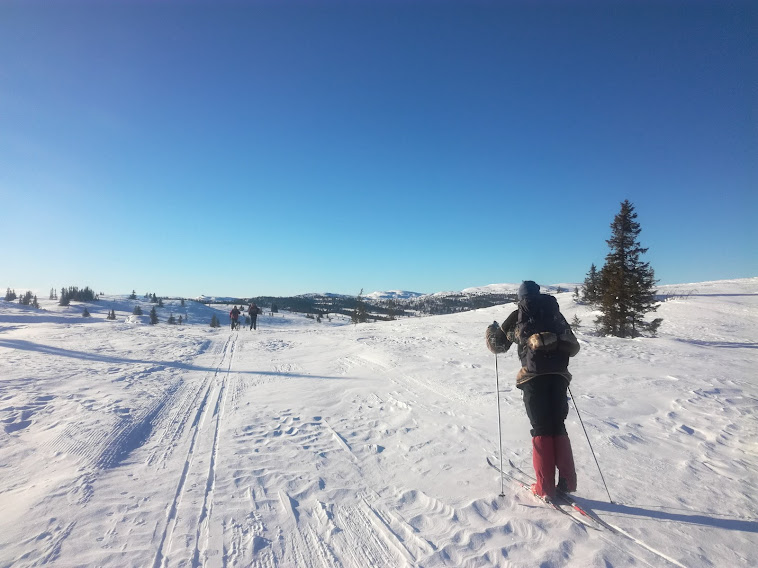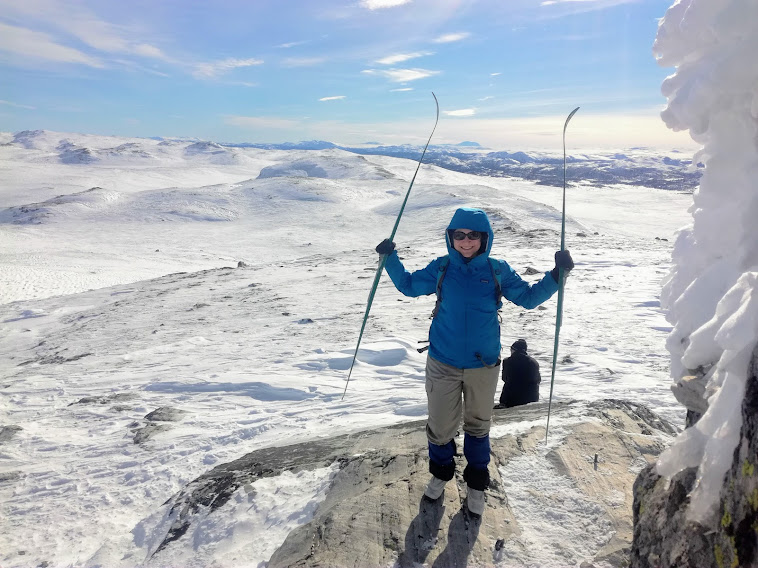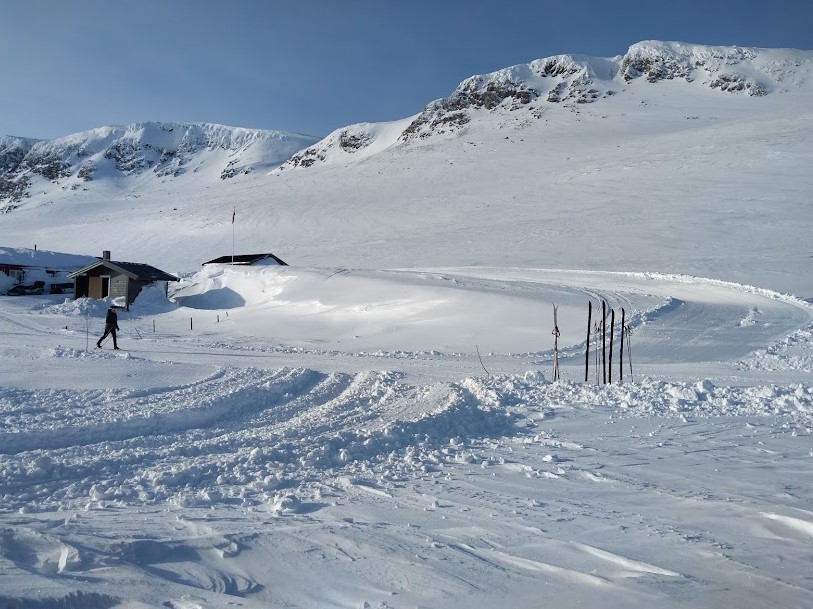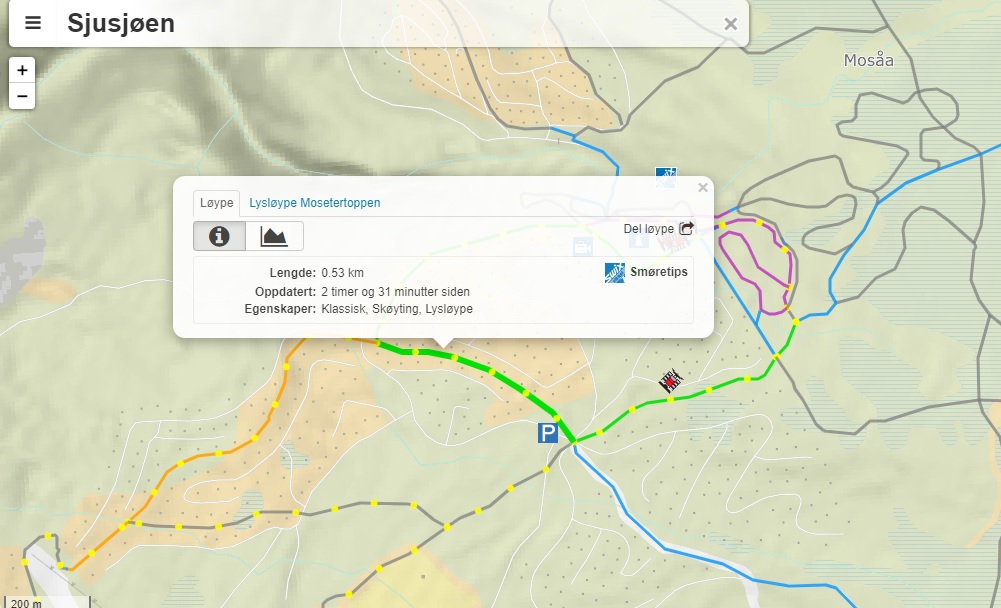Snow, serenity, northern lights and reindeers – the Norwegian winter wonderland is best discovered with skis attached to your feet. Being the cradle of Nordic skiing, Norway offers the best conditions for those who want to escape busy alpine skiing resorts and find some solitude and connection with nature. How to organise your skiing holiday in the land of the Vikings? What do you need to know before you put the skis on for the first time? Here is your ultimate guide to cross country skiing in Norway.
What the hell is cross-ntry skiing?
Cross country, backcountry, alpine, freestyle – there are plenty of types of skiing, and it is easy to get confused if you are a novice. Most people talking about skiing have alpine skiing in mind – the one where the lift brings you to the top of the mountain so that you can enjoy the fast ride downhill.
Cross country skiing is more like hiking, but with the skis on. The skis are much longer and thinner than the alpine skis. The heel of the binding is loose, so you can walk up as well, and not only ride down.


Cross-country skiing is cheaper (no ski-passes needed, as you do all the work with the power of your legs) and less injury-prone than alpine skiing which strains the knees quite a lot. With the movement being more natural, xc-skiing is less intimidating for most beginners.
There is a funny distinction between those two in the Norwegian language: to do alpine skiing is stå på ski, which means to stand on the skis, and cross-country skiing is gå på ski which means to walk on the skis.
There is also backcountry skiing, which is similar to cross-country. The main distinction is that cross country takes place on prepared tracks and back-country is everywhere, out in the wild.




Why in Norway?
They say Norwegians are born with skis on their feet. Norway offers probably the best conditions for xc-skiing in the world. Only in the forests surrounding the capital can you find more than 2600 kilometres of prepared tracks. And Oslo is not even the ski hub of the country.








Where?
Some of Norway’s best cross country skiing destinations are:
- Sjusjøen
- Gålå
- Beitostølen
- Hovden
- Hallingdal (Geilo and Hemsedal are very popular but if you need something more quiet visit Nesbyen – off the beaten track destination rarely visited by foreigners)
- Norefjell




Courses
First time on the skis? Get some advice from the experts! Norwegian ski association (Skiforeningen) offers regular courses in English (see more info on their website). You can also check out the offer of learn2ski and Telemark ski company.
You will also find some useful exercises in this video:
Best routes for multi-day adventures
Are you already familiar with skiing and are ready for a big outdoor adventure? You should plan a multi-day trip through the Norwegian mountains. There are many trails with mountain huts on the way where you can stay. For example these:
Eventyrløypa
Eventyrløypa means an adventure trail. A 115 km long trail crosses some popular ski destinations in Norway like Hemsedal, Golsfjellet and Flå. It will take you about four days with accommodation in self-serviced DNT cabins (read more about DNT mountain huts here). The whole trail is groomed (however, in the upper parts, the tracks might be destroyed by wind), and the highest point is 1298 m a.s.l.
You can find more information about the adventure trail here (it’s in Norwegian, but thank God there is Google Translate and DeepL).


Along Hardangervidda
Hardangervidda is the largest mountain plateau in Europe. Having a rough climate, it’s a place where polar explorers often train before their big expeditions. Therefore, it’s better to have some high mountain experience before heading on this trail. The best time to visit is early spring. You will need an entire week to cover 120 km. If you take this challenge, you can be sure it will be the adventure of a lifetime.
You can find more information and a map here.
Remember to check the weather conditions, take the compass and map and call the mountain huts where you are planning to sleep, to check if they are open.
When?
The skiing season in Norway is long – starting in late November and ending in May.
What is the best time to go? December is the darkest time of the year with polar light beyond the arctic circle and with only about 6 hours of daylight in the south. Therefore, in my opinion, it is better to visit Norway after the New Year.
In January and February, chances are best for smooth, powdery snow, and cold and frosty nights. If you’re lucky, you might see the Northern Lights, so make sure to follow Aurora Forecast (e.g. the one here). The further up north you go, the bigger the chance.
In spring, the conditions become a little more challenging. The snow melts during the day and freezes through the night, so the tracks might become icy. On a more positive note, the days become longer, so you can stay outside till 10 pm! It is usually more sunny and warm, and the breaks much are more pleasant than when the temperatures are below -10.
During the Easter holidays, you can expect mountains to get crowded. It is traditionally the time for Norwegians’ big skiing holidays. And if you want to feel like a local, there is nothing more Norwegian than going on a ski tour on the national holiday 17th of May to enjoy the last bits of snow in the mountains. Skiing in a t-shirt is a pretty cool experience!
Make sure to bring sunscreen! The snow reflects the sun rays and it is easy to get sunburned.
Useful resourses for cross country skiing in Norway
These websites are useful to plan your skiing holidays in Norway.
Unfortunately, this website is only available in Norwegian but it doesn’t take a genius to decode the colour codes even if the only word you know in this language is “hei”.
On Skisporet, you will find constantly updated information on the ski conditions all around the country. If a route is marked as green – the snowcat was there within the last three hours, which means that you can expect a smooth track with no bumps.
You can also check trails length, elevation profile, suitability for classic (nor. klassisk) and skating skiing (nor. skøyting) and if it is lighted (nor. lysløype). Click on “smøretips”, to will find advice on which wax you should use in current weather conditions.


Speaking of wax, “What type of wax did you use?” is the ultimate conversation starter in Norway. Usually avoiding small-talk, most Norwegians will be happily elaborate on the grip and glide and give you advice. They’ll assume, as a foreigner, you have no clue about klister, blue wax and red wax.
- For the most precise weather forecast, use yr.no (available in English)
- On ut.no, you can find route suggestions and cabins and open shelters, where you can plan your break. Unfortunately, the website is only available in Norwegian.
Transportation
The distances in Norway are big and the public transportation in the countryside is usually quite limited but some ski destinations are available by metro, bus or train.
Metro: if you are in Oslo, simply take the metro line 1 to Holmenkollen to explore some of the capital’s best trails.
From Lillehammer, there is a regular bus connection to Sjusjøen.
There are several ski destinations like Geilo, Finse or Flå accessible by train on the most famous Norwegian railway line from Oslo to Bergen (so-called Bergensbanen).


If you want to be more flexible, consider renting a car. Just be aware that driving in the mountains in the winter might be challenging if you are not used to it.
What to bring (except for skis)
- Gaiters
- Merino underwear
- Jacket – not too thick, you will sweat quite a lot!
- Sunscreen
- Thermos
- Something to sit on (a well isolating mat is a must-have during the breaks)


Tips and tricks
- Start early but not too early. Even though track groomers are early birds, they need some time to prepare all trails, so if you want to have perfect conditions, best to check on Skisporet, if they started yet.
- If it is windy – don’t go too high and stay below the tree line. In the upper parts, the wind will destroy the tracks.
- Make sure to bring a map and compass. In a blizzard or white-out, the marking of the trails may become indistinguishable and navigating will become a challenge.
Taking skis on the plane
If you already have skis at home, it is probably easiest to bring them along. If you’re going to stay longer, it will also be the cheapest option. You will have to check it in as sports equipment.
The rates vary from airline to airline. The rates below are for online bookings, the rates at the airport are significantly higher. (Updated on 04.12.2021).
| Norwegian | 35 euro | Only ski equipment (no clothes), max two bags and up to 23 kg. Must be packed in a “hard or padded case”. |
| Wizzair | 42 euro | Packed in a pouch (I used bubble wrap and tape and they accepted it too). |
| KLM | Free (if instead of your normal checked-in luggage) | Up to 300 cm (length + width + height) and up to 23 kg. Only skis, boots and poles are allowed. No reservation is required. |
| Lufthansa | Free | 1 pair of skis, boots and poles + helmet. Max. two pieces of baggage. Max weight 23 kg, max length 200 cm (so if you are very tall and your skis are long, you might have to pay extra). |
| SAS | Free as checked-in luggage (except for SAS Go Light) | Up to 23 kg, you need to request sports equipment during booking. |
Ski rental
Here are some examples of prices for the rental of cross country skis in various locations in Norway. If you want to find offers in other places, search Google for “langrenn skiutleie”.
Prices per set = skis, shoes, poles (100 NOK = 9,6 euro)
400 NOK / 1st day + 200 NOK for every next day
Sjusjøen 425 NOK/day, 1070 NOK /week + obligatory insurance 100 NOK/day
Hafjell 325 NOK/day, 895 NOK/week
Hovden 230 NOK/day, 700 NOK/week
Accommodation
If you have an authentic Norwegian experience, you should rent a hytte, a wooden cabin in the mountains, usually with skis on the walls and the fireplace. If you come with 3-4 friends, you will easily find a simple, cosy cabin for an affordable price (for Norwegian standards) on booking.com and airbnb.com.
Covid restrictions in Norway
You will find updated Covid restrictions before travelling to Norway on this website.








Pingback: How to train for a bicycle tour? - Wobbly Ride